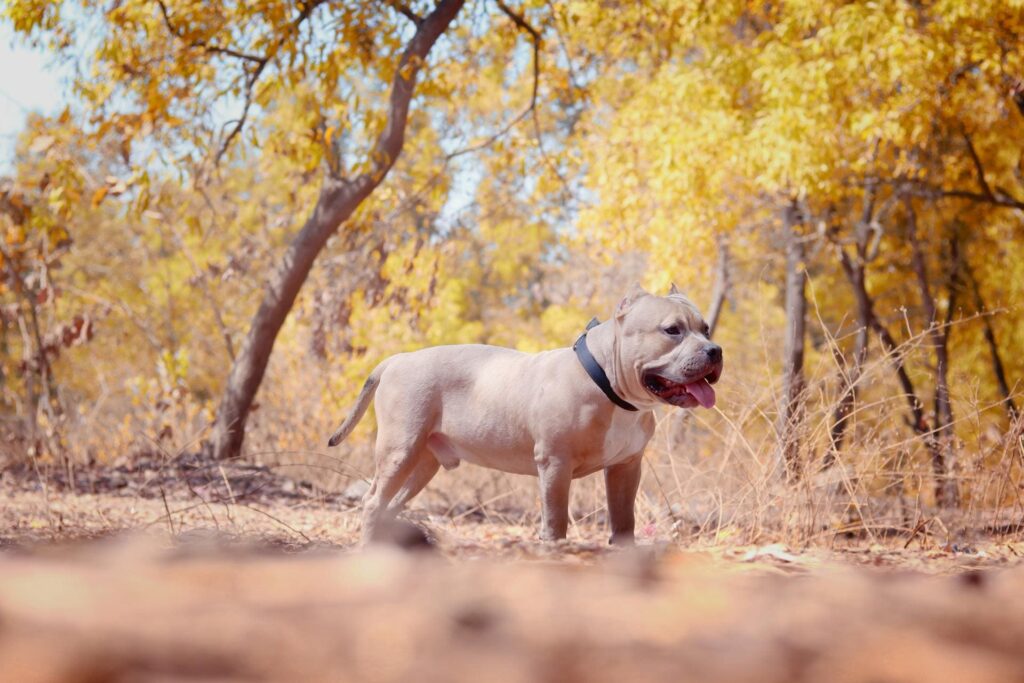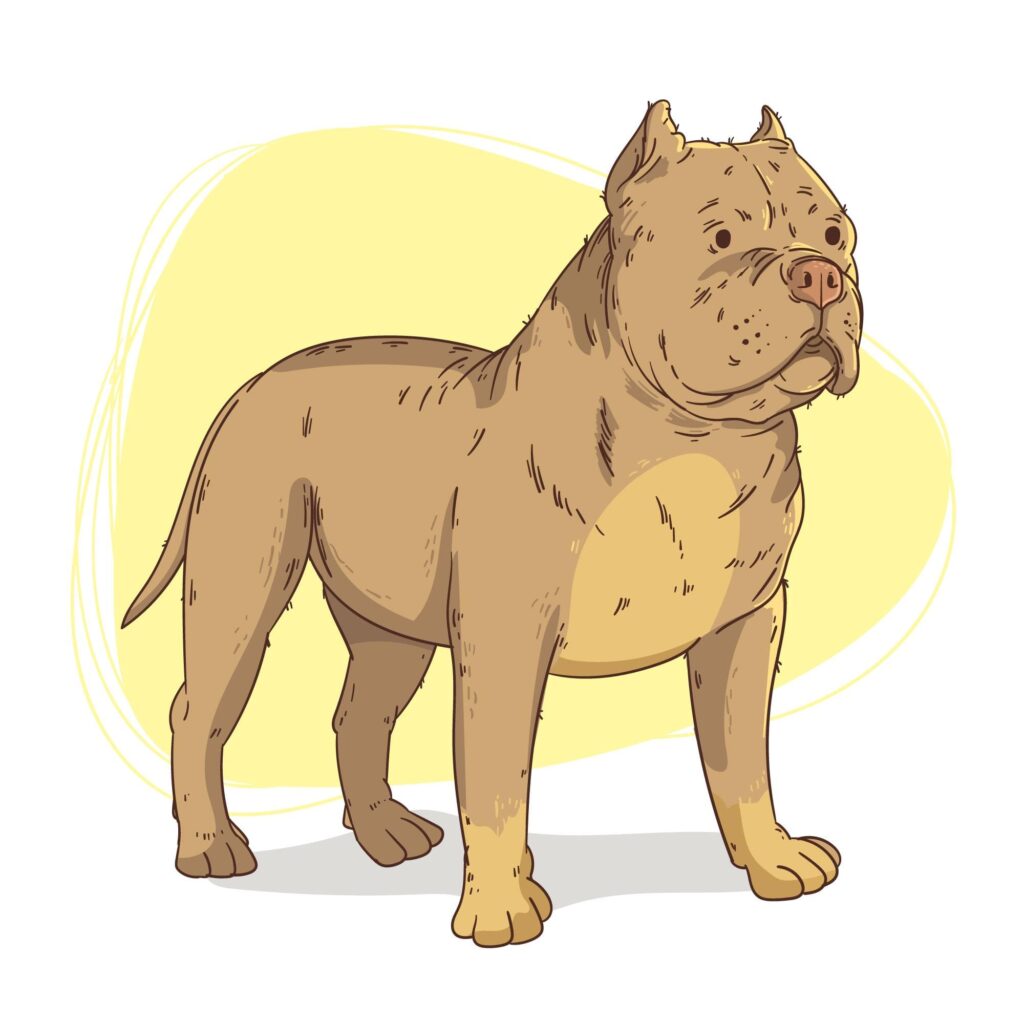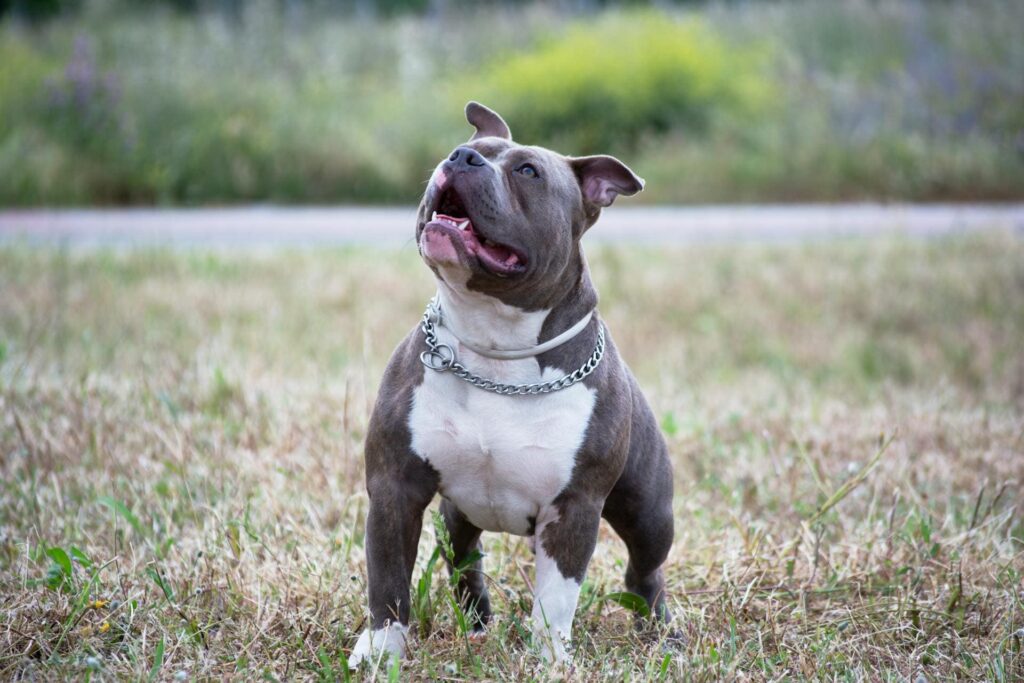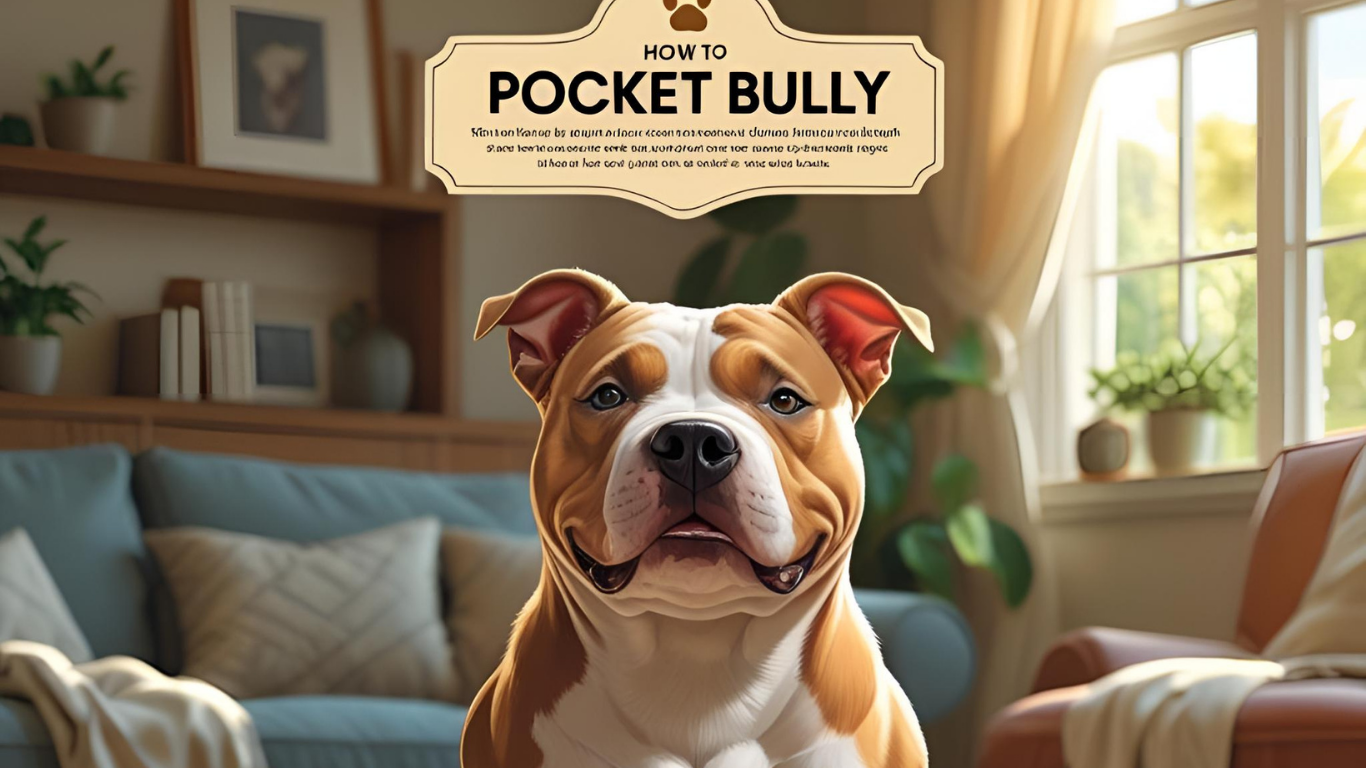Ever seen a dog that looks like a bodybuilder but acts like a teddy bear?
Meet the Pocket Bully—a compact, muscular dog with heart-melting loyalty and just the right dose of attitude.
Pocket Bullies are a hybrid breed, typically a cross between the American Pitbull Terrier and the Patterdale Terrier. They are known for their small size, similar to French Bulldogs, and often have a muscular build. While both parent breeds are purebred, Pocket Bullies are a mix.
Pocket Bullies are also known as “micro bullies” or “pocket pit bulls.” These fun-sized pups are part of a rising trend of designer bully breeds.
Despite their popularity, Pocket Bullies aren’t purebred dogs. They’re a cross between an American Bully and a Patterdale Terrier, giving them their compact yet muscular frame.
While the AKC (American Kennel Club) and UKC (United Kennel Club) haven’t officially recognized the Pocket Bully, fans and breeders are working hard to earn these lovable dogs a spot in the spotlight.
What Is a Pocket Bully?
A Pocket Bully, also known as a Pocket Pitbull, is a compact, muscular, and affectionate hybrid dog breed. It’s the smallest variety within the American Bully breed family, often standing between 13 and 17 inches tall at the shoulder—shorter than a standard American Bully.
Despite their name, Pocket Bullies are not small enough to fit in your pocket, but they are smaller and stockier than most bully breeds. Their charming personality and adorable appearance have made them incredibly popular with families and dog lovers alike.
Key Characteristics of a Pocket Bully
- Height: 13–17 inches
- Weight: 11–22 pounds (on average)
- Coat: Short, smooth, and low-shedding
- Colors: Wide variety including fawn, black, white, blue, and brindle
- Temperament: Friendly, loyal, playful, and affectionate
- Trainability: Medium to high – responds well to consistent training and socialization
- Energy Level: Moderate – needs regular exercise but also enjoys downtime

Pocket Bully Breed History
The Pocket Bully is kind of like the new kid in school—fresh, fun, and full of personality. This tough-but-sweet little dog started making waves in the 1980s and 1990s in the United States. Breeders wanted a pup that looked strong like a bulldog but had a gentle heart and friendly attitude.
To make the Pocket Bully, breeders mixed dogs like the American Pit Bull Terrier, American Staffordshire Terrier, and some bulldog-type breeds. They carefully chose dogs that were kind, loyal, and easy to train, leaving out the aggressive traits. The goal? A family-friendly dog with muscles and manners.
By the 1990s, breeders had the look and personality they wanted: a strong, short, and lovable dog. In 2004, the American Bully Kennel Club (ABKC) was created to make the breed official and set the rules for what makes an American Bully.
Then in 2013, the United Kennel Club (UKC) also said, “Yep, this pup deserves recognition!”
Since then, Pocket Bullies have become superstars of the bully world. They’re part of a family with four sizes:
- Pocket – the smallest (but mighty!)
- Classic
- Standard
- XL – the big boss
All puppies start as “Standard” bullies until they turn one. Then, based on their size, they’re sorted into their proper category.
So, while the Pocket Bully may be small, it has a big history filled with smart breeding, a loving nature, and a whole lot of heart.
What Does a Pocket Bully Look Like?
The Pocket Bully may be small in size, but don’t be fooled — this dog is built like a tiny tank! With a broad chest, thick neck, and muscles that pop, the Pocket Bully looks like it could be hitting the gym on the daily. But underneath that tough-guy look? A total sweetheart.
These pups have a balanced body, meaning everything is the right size — not too short, not too long. Their short legs don’t slow them down either; they can move fast, jump, and play like champs. And even though they look strong, they’re not clunky — Pocket Bullies are surprisingly agile and athletic.
One thing they don’t have? A squishy, smushed nose like a bulldog. Their nose is built for breathing, which helps them stay active and avoid breathing problems.
Pocket Bully Body Type
Pocket Bullies are medium-sized dogs with big, strong muscles that make them look super powerful. They have broad heads with strong cheek muscles and chunky jaws that fit perfectly with their sturdy bodies. Their wide chests give them a tough, solid look, but don’t be fooled — they’re built to be strong and agile!
Pocket Bully Coat Colors & Patterns
These dogs are basically walking art pieces. Pocket Bullies come in tons of colors — like:
- Black
- Fawn (light tan)
- Gray (sometimes called “blue”)
- Red
- White
- Golden
- …and mixes of these!
But here’s the catch: the merle pattern (a swirly, spotty look) isn’t accepted by official breed clubs like the American Bully Kennel Club (ABKC). So while it may look cool, it’s considered a “fault” in official shows.
| Color | Description | Fun Details |
| Black | Classic black coat, sometimes with white markings on chest or paws. | Sleek and shiny look. |
| Blue | Grayish-blue coat, often with white chest and feet. | Soft, cool tone. |
| Brindle | Striped pattern mixing black, brown, and gray like tiger stripes. | Looks like camo! |
| Chocolate | Dark brown coat, ranging from light milk chocolate to deep cocoa brown. | Delicious-looking! |
| Fawn | Light tan or beige, sometimes with white chest and feet markings. | Calm and classy. |
| Lilac | Rare light grayish-purple color, often with white chest and feet. | Magical, fantasy-like. |
| Merle | Marbled mix of blue, black, and brown colors. | Painted-splash effect; not always show-approved. |
| Red | Ranges from light reddish-brown to deep dark red, often with white chest and feet markings. | Bold and fiery color. |
| Tricolor | Mix of three colors—usually black, brown, and white—blended together. | Red carpet-ready look. |
Pocket Bully Size Guide
- Height: 13 to 17 inches (that’s about the size of a ruler and a half!)
- Weight: Around 30 to 45 pounds — like carrying a small bag of dog food!
They’re short, muscular, and sturdy, but still easy to manage compared to bigger breeds.
Coat Type: Smooth, Short & Shiny
The Pocket Bully’s coat is short and glossy, like they’re always ready for a doggy fashion show. It feels smooth when you pet it, and it doesn’t need much brushing. But heads up — they do shed, especially for people with allergies.
Bonus tip: Since their coat is short and they don’t have much fur to keep them warm, they should wear a cute doggy sweater or jacket when it’s cold outside. Yes, tough dogs can rock cozy outfits too!
Pocket Bully Breed Personality & Traits
- Super Loyal & Trainable: Pocket Bullies love learning new things and are really eager to make their humans happy. They make awesome companions and watchful guard dogs.
- Friendly but Protective: These pups are generally friendly and sweet but will step up to protect their family if they sense danger. So sometimes they might seem tough, but it’s all love.
- Good with Dogs, Maybe Not All Animals: Pocket Bullies usually get along well with other dogs, but might be unsure about other animals unless socialized well early on.
- Smart & Playful: They’re clever, love mental challenges, and need plenty of playtime. Long walks and running around in a safe yard keep them happy.
- Cuddle Bugs & Kid Lovers: These dogs adore snuggles and are great with kids. They also make loyal protectors for older people who want a loving pet.
- Positive Training Works Best: Using kind, reward-based training and early socializing helps Pocket Bullies grow into calm, confident, and friendly adults.
Pocket Bullies bring fun, love, and a bit of muscle to your life — all wrapped up in one adorable, loyal package!
Lock Jaw Myth — Busted!
You might have heard people say that bully breeds, like Pocket Bullies, have a “lock jaw” — meaning once they bite, they can’t let go. Well, that’s totally a myth!
According to a study by the Marin Humane Organization, dogs don’t have any special jaw mechanism that locks their bite. Their teeth and jaws work just like any other dog’s. So, no “lock jaw” here — it’s just a rumor that won’t quit.
If you want the facts straight, check out this myth-busting source: Animal Farm Foundation.
Pocket Bully Grooming & Care
Taking care of your Pocket Bully’s grooming is pretty simple but super important—especially because they’re smaller and need gentle handling.
Here’s your easy grooming checklist:
- Brush That Coat: Once a week is perfect! Brushing helps spread natural oils that keep their coat shiny and healthy. Plus, it gets rid of tangles and loose fur.
- Bath Time: Give them a bath about once a month—or whenever they get dirty—using a gentle, dog-friendly shampoo that won’t dry out their skin.
- Nail Care: Trim their nails carefully once a month. Watch out for the sensitive quick inside their nails so you don’t hurt them! If trimming’s tricky, a groomer or vet can help.
- Ear Cleaning: Regularly clean their ears to stop infections before they start. Pocket Bullies can be prone to ear problems if not kept clean.
- Dental Health: Did you know 80% of dogs show signs of gum disease by age 3? Brush your pup’s teeth daily and schedule dental check-ups with your vet to keep their smile bright and healthy.
By sticking to this routine, your Pocket Bully will stay happy, healthy, and looking their absolute best!

Exercise Tips for Your Pocket Bully
Pocket Bullies may be small, but they’re bursting with energy! To keep them happy, healthy, and well-behaved, they need 30 to 60 minutes of exercise every day. That’s right—these little powerhouses love to move!
Because every dog is different, it’s smart to chat with your vet about the best exercise plan for your Pocket Bully. But one thing’s for sure: despite their compact size, they often need more activity than other small dogs.
Why exercise?
It helps your Pocket Bully stay fit, maintain a healthy weight, and keeps boredom (and naughty behaviors) at bay.
5 Fun Exercise Ideas You & Your Pocket Bully Will LOVE
- Play Fetch
Classic and always a hit! Use a ball, frisbee, or any favorite toy in a safe yard or park. It’s great exercise and super fun. - Tug of War
Put their muscles to work! Grab a sturdy rope toy and enjoy a friendly tug session. It’s a fantastic way to bond and burn energy. - Hide and Seek
This game works indoors or outdoors and challenges their brain while giving them some action. Hide and call them—let the fun begin! - Hiking Adventures
Pocket Bullies love the outdoors! Take them on a safe, dog-friendly hike and soak up nature together. - Treibball
A cool sport where your dog herds big exercise balls into a goal using commands and body language. It’s playful, smart, and great exercise.
Remember, Pocket Bullies aren’t as hyper as some breeds, but daily activity is a must. Even just 30 minutes a day can keep your pup healthy and happy—and save your shoes from becoming chew toys!
Pocket Bully Temperament
The Pocket Bully is an affectionate and gentle dog with an outgoing personality. They bond strongly with their owners and are rarely aggressive due to selective breeding that reduces aggression.
Contrary to common misconceptions, Pocket Bullies are not naturally aggressive or unsuitable as family pets. Any aggression in dogs usually stems from poor upbringing rather than breed traits.
These dogs crave love and approval, making them highly trainable. However, lack of affection, harsh punishment, or poor socialization can lead to behavioral problems, just like with any breed.
Though their strength can make them capable of destructive behavior, this is usually a result of background and treatment, not instinct. By nature, Pocket Bullies are loving and seek affection, getting along well with others when properly socialized. Their temperament depends largely on how they are raised, not stereotypes.
Common Pocket Bully Health Problems
- Skin Issues: Pocket Bullies can have skin problems like eczema, caused by stress, allergies, or other factors.
- Brachycephalic Airway Syndrome: Like French Bulldogs, Pocket Bullies have shortened snouts which can cause breathing difficulties due to narrow nostrils and airways.
- Hip Dysplasia: This condition, common in many dogs, occurs when the hip socket doesn’t fit properly with the femur, leading to mobility issues.
- Bloat (Gastric Torsion): Deep-chested dogs like Pocket Bullies can suffer from bloat, where the stomach expands and may twist. This is a serious, life-threatening emergency requiring immediate care.
| Health Issue | Care Tips & Prevention | Detailed Explanation & Tips |
| Skin Issues (Eczema, Allergies) | – Regular grooming and bathing with gentle, hypoallergenic shampoos.- Identify and avoid allergens like certain foods or environmental triggers.- Consult your vet for allergy testing or medicated treatments. | Pocket Bullies may develop itchy, irritated skin from allergies or stress. Regular grooming helps remove allergens and keep skin healthy. If itching persists, a vet can help identify triggers and may prescribe medications or special diets. |
| Brachycephalic Airway Syndrome | – Avoid excessive heat and strenuous exercise.- Keep your dog at a healthy weight to reduce breathing stress.- Watch for signs of breathing difficulties such as noisy breathing, coughing, or fainting.- Consult your vet if you notice any symptoms. | This condition affects dogs with shorter noses and narrow airways, causing breathing problems. Pocket Bullies share traits with brachycephalic breeds. Keeping your dog cool, calm, and fit can help prevent complications. |
| Hip Dysplasia | – Maintain a healthy weight to reduce joint stress.- Provide moderate, low-impact exercise such as swimming or gentle walks.- Use joint supplements like glucosamine if recommended by your vet.- Schedule early vet check-ups to detect issues before they worsen. | Hip dysplasia happens when the hip joint doesn’t fit properly, causing pain and mobility problems. Preventing obesity and encouraging safe exercise can improve joint health. Early detection helps manage symptoms and slows progression. |
| Bloat (Gastric Torsion) | – Feed smaller, more frequent meals instead of one large meal.- Avoid vigorous exercise before and after meals.- Watch for symptoms like a swollen belly, drooling, or retching.- Seek emergency veterinary care immediately if you suspect bloat. | Bloat is a life-threatening condition where the stomach twists, cutting off blood flow. Deep-chested dogs like Pocket Bullies are at risk. Prompt treatment is critical, so recognizing symptoms early can save your dog’s life. |
Cost of Caring for a Pocket Bully
Pocket Bullies are an exotic and rare breed, which means their initial purchase price can be quite high. However, investing in proper care from the start can help prevent costly health problems down the road.
While the upfront costs—including buying the dog, vaccinations, spaying/neutering, and basic supplies—might seem steep, they’re usually less expensive than facing a lifetime of expensive medical bills caused by neglect or poor care.
One smart way to manage potential health expenses is pet health insurance. By paying a predictable monthly fee plus an annual deductible, you can avoid the shock of unexpected emergency vet bills. This makes budgeting for your Pocket Bully’s care easier and helps ensure they get the medical attention they need without delay.
Pocket Bullies are a rare and exotic breed, so their initial purchase price can range from $2,000 to $5,000 depending on breeder reputation, lineage, and location.
Beyond the upfront cost, here’s what you can expect for ongoing care expenses:
| Expense Category | Estimated Cost (Annual) | Notes |
| Food | $300 – $600 | High-quality dog food for a medium-sized dog. |
| Routine Vet Care | $200 – $500 | Annual check-ups, vaccinations, flea/tick prevention. |
| Pet Health Insurance | $300 – $600 | Depends on coverage level and age of dog. |
| Grooming | $100 – $300 | Brushing, occasional baths, nail trims. |
| Dental Care | $100 – $300 | Professional cleanings and daily teeth brushing supplies. |
| Emergency Vet Care | $500 – $2,000+ | Varies; important to have insurance or savings for emergencies. |
Tips to Save on Costs:
- Pet insurance helps spread out the risk of expensive emergencies.
- Regular grooming and dental care prevent costly health issues.
- Feeding a balanced diet supports overall health and reduces vet visits.
Diet and Nutrition
- A well-balanced diet is essential to prevent obesity and other health problems in your Pocket Bully.
- Deep-chested breeds like the Pocket Bully are more prone to bloat, so it’s best to split their daily food portion into two meals rather than feeding all at once.
- Always consult your veterinarian to determine the ideal diet tailored to your dog’s individual needs, life stage, and any health concerns.
- Since the Pocket Bully is a mixed breed, the amount of food varies per dog — your vet will help guide you on the right quantity.
Are Pocket Bullies Good With Kids?
Pocket Bullies are patient and have a sweet temperament, making them excellent companions for families with children. They often tolerate rowdy behavior well, but it’s important to teach kids how to properly interact with dogs to ensure safety and respect on both sides.
A well-socialized Pocket Bully gets along great with children of all ages and helps keep the family active. With plenty of space and a favorite ball, these energetic pups can provide hours of fun and entertainment for kids.
Tips for Safely Introducing Kids to Pocket Bullies
- Supervise all interactions: Always watch when kids and dogs are together, especially with younger children, to prevent accidental rough play or misunderstandings.
- Teach gentle touch: Show children how to pet the dog softly and avoid pulling ears, tails, or fur.
- Respect the dog’s space: Kids should learn not to disturb the dog while it’s eating, sleeping, or resting in its bed.
- Use positive reinforcement: Reward both the dog and children with praise or treats for calm, respectful behavior around each other.
- Set clear boundaries: Teach kids to avoid sudden loud noises or fast movements that might startle the dog.
- Encourage communication: Help kids recognize dog body language—like wagging tails or growling—so they can respond appropriately.
With these steps, Pocket Bullies and children can build a safe, loving, and lasting bond.

Are Pocket Bullies Good With Other Animals?
Yes, Pocket Bullies can get along well with other animals—especially when they’re properly socialized from a young age. With slow introductions and supervision, they can live peacefully with cats, dogs, and even small animals.
They don’t typically have a strong prey drive, but their playful nature means they can sometimes play too rough, especially with smaller pets. Socialization and training are key to ensuring safe and friendly interactions.
Are Pocket Bullies Aggressive?
Pocket Bullies are not naturally aggressive. In fact, aggression is considered a flaw in this breed. They’re known for being affectionate and people-oriented.
Like any breed, however, poor socialization or traumatic experiences can lead to fear-based behavior. But even adult Pocket Bullies from tough backgrounds can learn to trust and become gentle with the right training and environment.
Do Pocket Bullies Bark?
Generally, Pocket Bullies are quiet dogs. They don’t bark excessively, which makes them great for apartment living. However, they will bark if something seems off, like a stranger approaching or unusual sounds around the home.
Boredom and separation anxiety can also cause barking. If your Pocket Bully is barking more than usual, make sure they’re getting enough exercise, attention, and mental stimulation.
Are Pocket Bullies Affectionate?
Absolutely. Pocket Bullies are affectionate, loving companions that form strong bonds with their humans. They love attention and are just as happy snuggling on the couch as they are running in the yard.
While some may be shy around strangers, most Pocket Bullies are friendly and welcoming when properly socialized. Their loyalty and cuddly nature make them ideal family pets.
Are Pocket Bullies Intelligent?
Yes, Pocket Bullies are smart dogs. They’re curious, intuitive, and can often read your emotions just by looking at you. Their intelligence makes them quick learners, but it also means they get bored easily.
To keep a Pocket Bully happy, you’ll need to switch up their routine with new tricks, puzzle toys, or engaging games. Mental stimulation is just as important as physical exercise.
Are Pocket Bullies Energetic?
Pocket Bullies have medium to high energy levels. Some are more active than others, depending on their genetics. While they’re stocky and muscular, they don’t have a lot of stamina.
Daily walks and short play sessions are usually enough to meet their exercise needs. Just be cautious in hot weather—Pocket Bullies can overheat quickly due to their build. Always provide water and allow breaks after intense activity.
Are Pocket Bullies Easy to Train?
Yes, Pocket Bullies are eager to please and pick up new commands quickly. Their intelligence and desire to make their owners happy make them easy to train—even for first-time dog owners.
Positive reinforcement works best. Use treats, praise, and play to motivate them. Harsh corrections can backfire, so always keep training fun and rewarding.
Are Pocket Bullies Good Watchdogs?
While Pocket Bullies can be protective, they’re not your typical guard dogs. They don’t usually bark at every noise or unfamiliar face. Instead, they’re more curious than suspicious.
That said, they won’t hesitate to defend their family if they sense a real threat. Their loyalty runs deep, and they’ll step in if someone they love is in danger.
Are Pocket Bullies Good Service Dogs?
Pocket Bullies can be trained to perform specific tasks, but they’re not ideal service dogs. Their compact size and limited stamina can be a drawback for people needing full-time assistance.
Also, the public stigma surrounding bully breeds can cause distractions in public places. However, Pocket Bullies make excellent emotional support animals (ESAs) and therapy dogs thanks to their gentle, affectionate nature.
How Long Do Pocket Bullies Live?
Pocket Bullies typically live between 10 to 14 years, depending on their genetics, diet, exercise, and overall care. They’re considered a healthy and resilient breed, especially when responsibly bred.
To help your Pocket Bully live a long and happy life, it’s important to provide:
- High-quality food tailored to their needs
- Daily exercise to prevent obesity
- Regular vet checkups and vaccinations
- Good dental hygiene
- Mental stimulation to keep their minds sharp
With the right environment and plenty of love, your Pocket Bully can enjoy a full and active life well into their senior years.

Is a Pocket Bully the Right Dog for Me?
If you’re looking for a loyal, affectionate, and low-maintenance companion, the Pocket Bully might be your perfect match. These dogs are known for their sweet temperaments and deep devotion to their families. They thrive in small to medium-sized homes and love both playtime and cuddle sessions.
However, there’s one non-negotiable: socialization. Pocket Bullies need consistent exposure to new people, places, and animals—especially during their puppy and teenage years. Without it, they may become overly protective or difficult to manage.
If you’re able to commit time early on for training and social experiences, a Pocket Bully can be a well-mannered, confident, and incredibly affectionate addition to your family. They’re a great fit for active individuals, couples, and even families with kids and other pets—so long as you’re ready to give them the structure and love they crave.
Breeds Similar to the Pocket Bully
American Bully:
The parent breed of the Pocket Bully, developed in the 1990s as a mix of companion and guardian traits. They have a gentle temperament, great for families, but will defend their home if needed.
American Staffordshire Terrier:
Recognized by the AKC, this pit bull breed typically weighs 40 to 70 pounds. They are larger than Pocket Bullies but smaller than American Bullies and often have distinctive white chest markings.
French Bulldog:
Though not related, French Bulldogs resemble Pocket Bullies in size and compactness. They are extremely popular in the U.S. and easier to find than the rarer Pocket Bully.
Quick Summary – Top Pocket Bully FAQ’s Answered
What is a Pocket Bully?
A hybrid dog breed, the Pocket Bully is a mix of the American Pit Bull Terrier and the American Bulldog.
What does a Pocket Bully look like?
Small and muscular, Pocket Bullies have a thick, wide head, short stocky legs, a broad chest, and a rounded rump. Their shoulder height usually ranges from 13 to 17 inches.
What are the breed characteristics of a Pocket Bully?
Known for loyalty and ease of training, Pocket Bullies make great pets and guard dogs. They are friendly, affectionate, and enjoy mental stimulation, walks, playtime, and socializing with people.
What is the history of the Pocket Bully breed?
Developed in the United States between the 1980s and 1990s, the Pocket Bully was recognized by the American Bully Kennel Club (ABKC) in 2004 and the United Kennel Club (UKC) in 2013.
Why do people keep Pocket Bullies as pets?
Created by crossing the American Pit Bull Terrier with the Patterdale Terrier, Pocket Bullies were bred to be strong-looking family companions that don’t require excessive exercise.
What breed makes a Pocket Bully?
Pocket Bullies are primarily a mix of the American Pit Bull Terrier and the American Bulldog, sometimes crossed with other bully breeds like the Patterdale Terrier to create their compact, muscular build.
Are Pocket Bullies aggressive?
No, Pocket Bullies are generally affectionate and gentle. They have had much aggression bred out of them and are known to be loyal, loving family companions. Aggression usually stems from poor upbringing or lack of socialization, not the breed itself.
What is the breed standard for a Pocket Bully?
The Pocket Bully breed standard emphasizes a compact, muscular body with a thick, wide head, broad chest, and a height between 13 to 17 inches at the shoulder. They should have a friendly temperament, strong build, and a smooth or rough coat depending on genetics.
What are Pocket Pitbulls mixed with?
Pocket Pitbulls are typically mixed with the American Bulldog and sometimes other bully breeds like the Patterdale Terrier to achieve their smaller, stockier size and distinctive appearance.
Final Thoughts
Pocket Bullies are more than just compact, muscular dogs—they’re loyal companions with big hearts and even bigger personalities. From their affectionate nature and playful energy to their intelligence and trainability, they offer the best of both worlds: a cuddle buddy and a confident protector.
Like any dog, they require time, commitment, and especially socialization, but if you’re willing to invest in their well-being, they’ll reward you with years of unconditional love and joy. Whether you’re a first-time dog owner or a seasoned pet parent, the Pocket Bully might just be the four-legged best friend you’ve been looking for.
You Can See More Dog Breeds Here.




